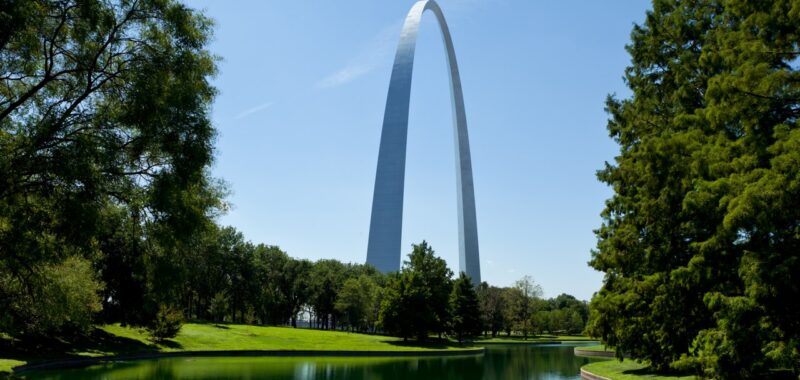There’s hardly a more recognizable landmark in the Midwest than the Gateway Arch in St. Louis, a monument honoring Thomas Jefferson and his ideas for America’s westward expansion. Reaching 630 feet into the air, it’s the tallest monument in the United States and the tallest arch in the world. Designed by the American Finnish architect Eero Saarinen, the arch was an engineering feat—in fact, many people thought it would fall over. But as a testament to the architects, engineers, and workers who built it, the Gateway Arch has long stood the test of time. “The Arch has always been one of the world’s most significant architectural marvels and an iconic symbol of that midcentury era,” says architect Jason Cadorette, senior associate at Cooper Robertson, which worked on a refurbishment project at the arch in 2018. Here’s everything you need to know about the Gateway Arch.
The Gateway Arch at a glance
The iconic Gateway Arch is the defining feature of Gateway Arch National Park in St. Louis. “The Gateway Arch represents St. Louis as the ‘Gateway to the West,’” says Pam Sanfilippo, program manager of Museum Services & Interpretation at Gateway Arch National Park. It was designed by architect Eero Saarinen, who won a competition for the project. You can plan your visit at nps.gov/jeff.
Where is the Gateway Arch?
The riverfront Gateway Arch is located in downtown St. Louis, Missouri; it’s situated on the bank of the Mississippi River, representing the westward expansion of the United States.
How tall is the St. Louis Gateway Arch?
The arch is 630 feet tall and 630 feet wide. Since you’re not always looking at the arch straight on, you experience an illusion that it’s much taller than it is wide.
What is inside the Gateway Arch?
The Gateway Arch is more than just a monument, it’s also a striking observation deck. A tram system takes visitors to the very top offering views of the greater St. Louis area. The legs hold stairs, but these aren’t accessible to the public and only used in emergencies or for maintenance. Underground is a visitors center.
History of the Gateway Arch
In 1935, President Franklin D. Roosevelt signed an executive order to establish the Jefferson National Expansion Memorial in the city of St. Louis, as a national monument for “Thomas Jefferson’s vision of a unified continental nation and St. Louis’s role as a confluence and gateway to the American West during the 1800s,” says Sanfillippo. But the Gateway Arch itself came much later.
A design competition for the monument was announced in 1945. “It gave liberty to designers to design whatever best expressed the memorial’s theme,” says Sanfillippo. “Eero Saarinen’s arch was unanimously chosen out of 172 entries.”
Who built the gateway arch?
Eero Saarinen was the designer of the Gateway Arch. The acclaimed Finnish American architect is best known for his structures like the TWA Flight Center in New York and the main terminal at Dulles International Airport outside of Washington, DC, as well as furniture designs like the iconic Tulip chair and pedestal table. “The Gateway Arch is such a perfect expression of Saarinen’s sculptural approach, and with the museum and surrounding grounds it also embodies modernism’s goal of integrating landscape design, art, and interior design with architecture,” says Cadorette.
When was the gateway arch built?
Construction began in 1963 and was completed in 1965, and it opened to the public in 1967. But that wasn’t the end of the design story for the Gateway Arch.
“One of the important points to recognize about this architectural history is that Saarinen actually died two years before construction began on the arch itself, so in many ways, his full vision was never realized,” says Cadorette. “The grounds were cut off from the rest of St. Louis by a highway, the museum ended up becoming something of an afterthought, and the landscape plan was not built out in the way its designers had intended.”


